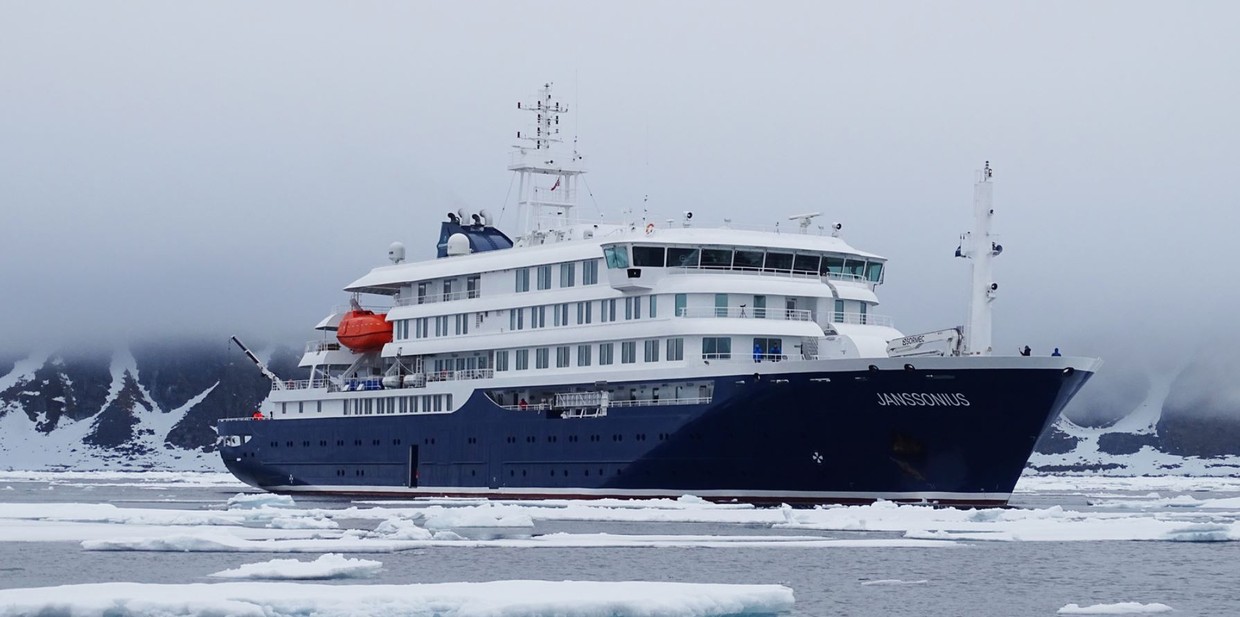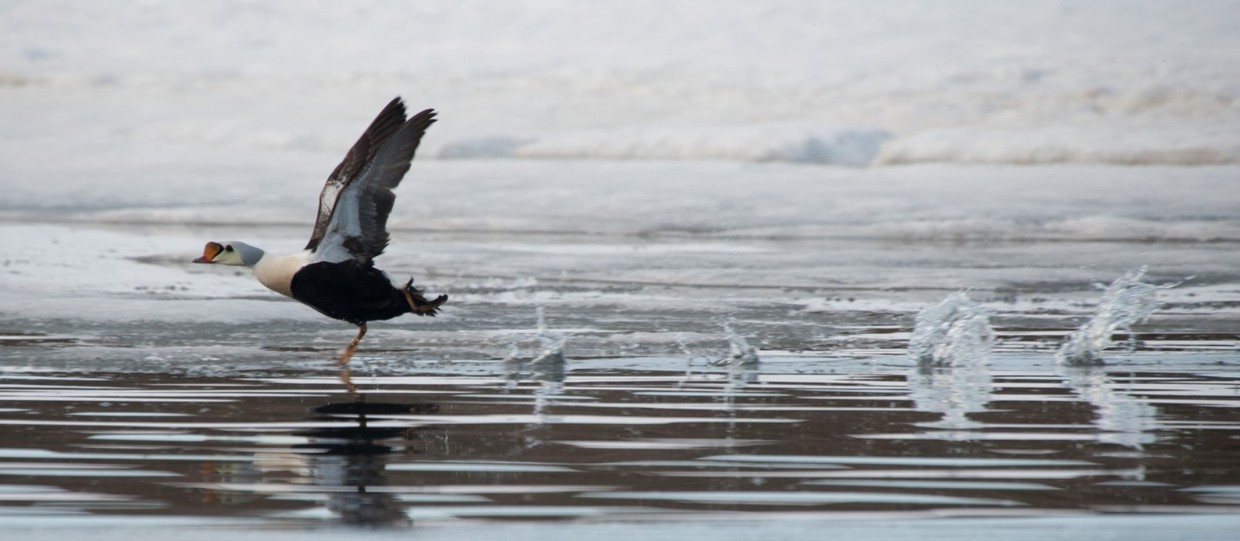from$ 6294 AUD
Note: Current p/p indicative rate. Final price may change due to currency fluctuations.
Janssonius
Longyearbyen to Longyearbyen
Overview
Experience the high Arctic summer solstice with an expedition that visits some of the top sites of eastern Spitsbergen. Our goal is to take you to amazing glaciers, fascinating historical sites, bountiful seabird colonies, and sprawling fjord systems in which there is a good chance of spotting whales, seals, and possibly even polar bears.
Departures
Cruise Itinerary
You touch down in Longyearbyen, the administrative center of Spitsbergen, the largest island of the Svalbard archipelago. Enjoy strolling around this former mining town, whose parish church and Svalbard Museum make for fascinating attractions. Though the countryside appears stark, more than a hundred species of plant have been recorded in it. In the early evening the ship sails out of Isfjorden, where you might spot the first minke whale of your voyage.
We start the day by quietly cruising the side fjords of the spectacular Hornsund area in southern Spitsbergen, enjoying the scenery of towering mountain peaks. The mountain of Hornsundtind rises to 1,431 meters (4,695 feet), while the peak of Bautaen testifies to why early Dutch explorers gave this island the name Spitsbergen, meaning “pointed mountains.” There are 14 magnificent glaciers in the area, and we have a fair chance of encountering seals and polar bears. The nearby cliffs of Sofiakammen are also home to thousands of pairs of nesting kittiwakes and little auks, and in the evening, we might see thousands of harp seals rutting on ice floes at Sørkapp.
After navigating the drift ice of Storfjorden, where we sometimes see harp seals, we land in northwest Edgeøya at the northern bank of Rosenberdalriver. Here on the raised beach, we have the opportunity of walking to Rosenbergdalen, which is teeming with grazing reindeer. Afterward we plan to walk by a cliff with nesting black guillemots on our way to Stretehamna, where we often find a herd of walruses on the beach near an octagonal trapper’s cabin built in 1905. We can also see the remains of a 19th-century Pomor house as well as the bones of walruses hunted in previous centuries.
Sailing into the waterway of Freemansundet, we plan to land at the tundra lowland of Sundneset, on the island of Barentsøya. Here we will visit the hut of a German scientific expedition (Würzbugerhütte) from sixty years ago, then take a brisk walk across the tundra in search of Spitsbergen reindeer and barnacle geese. After that, we plan to go on a Zodiac cruise near Freeman Glacier and visit a kittiwake colony in a canyon close by. In case of heavy ice in Freemandundet, however, we will instead sail to Negribreen, one of the most extensive glacier fronts on the east side of Spitsbergen. Here we can take a Zodiac cruise and land on Walrus Island, which became ice-free at the end of last century.
Today we sail to the east side of west Spitsbergen (west side of Storfjorden). Here we plan to walk to breeding places for ivory gulls in Agardhfjellet, which stands about 300 meters (980 feet) high. The valley leading to the outcrops that house the nests is littered with fossils of belemnites and ammonites.
Today we aim to land at the mountain of Stellingfjellet, near the largest colony of Brünnich’s guillemots in Spitsbergen. Later in the day, we will make landings at the rarely visited coast of south Spitsbergen, at the bay of Isbukta.
We continue our voyage in Bell Sund, one of the largest fjord systems in Svalbard. The ocean currents make this area slightly warmer than other areas in the archipelago, which shows in the relatively lush vegetation. Here there are excellent opportunities to enjoy both history and wildlife. A possibility is Ahlstrandhalvøya, at the mouth of Van Keulenfjorden, where piles of beluga skeletons can be found. These remains of 19th-century whale slaughter are a haunting reminder of the consequences of rampant exploitation. Fortunately, belugas were not hunted into extinction, and you have a good chance of coming across a pod. Alternately, while cruising the side fjords of Bellsund, we can explore tundra where reindeer like to feed as well as rock slopes where little auks are breeding.
Every adventure, no matter how grand, must eventually come to an end. You disembark in Longyearbyen, taking home memories that will accompany you wherever your next adventure lies.
All itineraries are for guidance only. Programs may vary depending on ice, weather, and wildlife conditions. Landings are subject to site availabilities, permissions, and environmental concerns per AECO regulations. Official sailing plans and landing slots are scheduled with AECO prior to the start of the season, but the expedition leader determines the final plan. Flexibility is paramount for expedition cruises. The average cruising speed of our vessel is 10.5 knots.
Janssonius

Vessel Type: Polar Class 6 Cruise Ship Length: 107.6 metres Passenger Capacity: 170 in 80 cabins Built: 2019/2020 Happier polar passengers, healthier polar environment Not only will the numerous amenities and on-board entertainments help make your Janssonius voyage truly memorable, this ship also gives you the peace of mind that comes with choosing one of the most environmentally friendly vessel on the polar seas. Janssonius uses LED lighting, steam heating, bio-degradable paints and lubricants, and state-of-the-art power management systems that keep fuel consumption and CO2 levels minimal. This means that when you sail aboard Janssonius, you get to enjoy the exotic landscapes and wildlife as much as possible while impacting them as little as possible. Hotel comfort, expedition class Janssonius offers high-quality accommodation for 170 passengers in six grand suites with balconies (27 square meters, 291 square feet), eight junior suites (19 to 20 square meters, 205 to 215 square feet), eight superior cabins (20 to 21 square meters, 215 to 226 square feet), 11 twin deluxe cabins, (19 to 21 square meters, 205 to 226 square feet), 14 twin window cabins (12 to 14 square meters, 129 to 151 square feet) as well as 27 twin porthole cabins, two triple porthole cabins, and four quadruple porthole cabins that vary in size from 12 to 18 square meters, or 129 to 194 square feet. The passenger capacity certificate for Janssonius is 196 persons. One deck consists of a large observation lounge and separate lecture room, which are reserved for a wide variety of interactive workshops, exhibitions, and performances particular to Janssonius. Though elegantly designed in stylish mid-century modern décor, this vessel holds true to Oceanwide’s distinctive cozy and informal atmosphere. Swift & safe ship-to-shore operations It is our philosophy to keep sea time short so that we can focus instead on fast, effective access to shore and near-shore activities. To give you the maximum contact with the nature and wildlife you traveled so far to see, we employ a tough fleet of rigid-hull inflatable Zodiac boats that guarantee swift and safe landing operations for the passengers. Janssonius has two separate gangways and a sheltered indoor Zodiac embarkation platform that can also be used for special outdoor activities, such as kayaking. The fast, flexible, friendly heart of the polar regions Our top priority is taking advantage of every wildlife and terrain opportunity as it occurs. To keep our itineraries flexible itineraries and our response time rapid, Janssonius is equipped with advanced stabilizers and two main engines capable of powering the vessel up to 15 knots. But Janssonius sacrifices no warmth to achieve its keen polar edge: You will have 72 crew and staff members (including expedition and hotel staff) at your service while on board, ensuring that what little time you do spend on the ship you will spend comfortably entertained.
Highlights
• Zodiac Cruising & Shore Program • Shore-Based Walking • Barentsøya • Edgeøya • Harp Seal • Kittiwake • Walrus • Ivory Gull
Map



